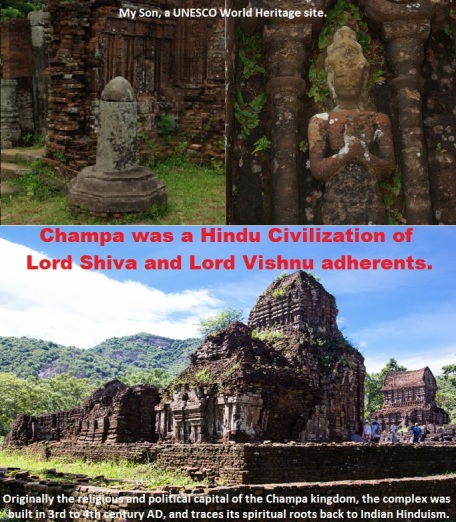Chaitra Shukla paksha 8, Kaliyug Varsh 5117

To feel the world-wide Hindu civilization once upon a time, here is the story of Champa dynasty now existing as a UNESCO world heritage site of “My Son Sanctuary” in Vietnam. Between the 4th and 13th centuries a unique culture which owed its spiritual origins to Indian Hinduism developed on the coast of contemporary Vietnam. This is graphically illustrated by the remains of a series of impressive tower-temples located in a dramatic site that was the religious and political capital of the Champa Kingdom for most of its existence.
Though, Vietnam is an atheist state, officially, but a significant section of the population still practises traditional religions; some adhere to Buddhism much influenced by Hinduism and there are quite a few Catholics left over from the French occupation.
The property of ‘My Son- Champa’ complex was recognized as a National Site in 1979 by the Culture Ministry and as a Special National site in 2009 by the national government of Vietnam.
A strategy for the revision of the Conservation Master plan of My Son is being developed as part of the current UNESCO Asia- Pacific World Heritage site project for My Son, and should be integrated within an up to date Management Plan for the site.
To further the safeguarding of the property, the Prime-Minister of Viet Nam promulgated Decision 1915/ QĐ-TTg, which gave formal approval and provided budgetary support for the property’s Master Plan (2008 to 2020) for the conservation and tourism promotion of the property.
However, isolated not far from Hoi An, is My Son, a UNESCO World Heritage site, once the location of the ancient Hindu Champa civilisation and its majestic complex of temples dedicated to Lord Shiva and Lord Vishnu.
Originally the religious and political capital of the Champa kingdom, the complex was built around the third or fourth century AD, and traces its spiritual roots back to Indian Hinduism. The city was forgotten with the passing of the Cham reign and for centuries sat hidden in the jungle.
My Son Sanctuary dates from the 4th to the 13th centuries CE. The property is located in the mountainous border Duy Xuyen District of Quang Nam Province, in central Vietnam. It is situated within an elevated geological basin surrounded by a ring of mountains, which provides the watershed for the sacred Thu Bon river. The source of the Thu Bon river is here and it flows past the monuments, out of the basin, and through the historic heartland of the Champa Kingdom, draining into the South China Sea at its mouth near the ancient port city of Hoi An. The location gives the sites its strategic significance as it is also easily defensible.

The tower temples were constructed over ten centuries of continuous development in what was the heart of the ancestral homeland of the ruling Dua Clan which unified the Cham clans and established the kingdom of Champapura (Sanskrit for City of the Cham people) in 192 CE. During the 4th to 13th centuries CE this unique culture, on the coast of contemporary Vietnam, owed its spiritual origins to the Hinduism of the Indian sub-continent. Under this influence many temples were built to the Hindu divinities such as Krishna and Vishnu, but above all Shiva. Although Mahayan Buddhist penetrated the Cham culture, probably from the 4th century CE, and became strongly established in the north of the kingdom, Shivite Hinduism remained the established state religion.
The monuments of the My Son sanctuary are the most important constructions of the My Son civilization. The tower temples have a variety of architectural designs symbolizing the greatness and purity of Mount Meru, the mythical sacred mountain home of Hindu gods at the center of the universe, now symbolically reproduced on Earth in the mountainous homeland of the Cham people. They are constructed in fired brick with stone pillars and decorated with sandstone bas-reliefs depicting scenes from Hindu mythology. Their technological sophistication is evidence of Cham engineering skills while the elaborate iconography and symbolism of the tower-temples give insight into the content and evolution of Cham religious and political thought.

The My Son Sanctuary is a remarkable architectural ensemble that developed over a period of ten centuries. It presents a vivid picture of spiritual and political life in an important phase of the history of South-East Asia.
Consisting of 70 ruins over 57ha, the site was rediscovered and renovated by the French in the late 1890s, but was subsequently heavily bombed during the Vietnam War, when it was found to be a hiding place for the Viet Cong.
Parts of the site are gradually being reconstructed using the traditional red bricks of the original work, although some of the very early work looks clumsy. Under government supervision, more recent reconstruction and renovation work is now of a high standard, with de-mining of the area being an early priority and still an important consideration for the wider areas around the site.
My Son is an extraordinary example of an ancient Hindu history – and one which kept written records. Much was recorded on perishable materials, but a great deal has been preserved on stone slabs or pillars and these have been a precious source of information for scholars, historians and archaeologists.
The My Son Sanctuary of UNESCO world heritage site is easily accessible from Hoi An or Da Nang, on Vietnam’s south central coast.
Source : hinduexistence




